Systolic Heart Disease: Pathogenesis, Nursing Strategies, and Drug Mechanism of Action
VerifiedAdded on 2022/10/03
|8
|1920
|155
AI Summary
This article discusses the pathogenesis, nursing strategies, and drug mechanism of action for systolic heart disease. It includes a case study of Mrs. Brown, a 78-year-old woman with systolic heart disease, and her clinical manifestations. The article also provides evidence-based rationales for two high priority nursing strategies to manage Mrs. Brown. Additionally, it discusses the mechanism of action of two drugs given to Mrs. Brown: IV Furosemide (Lasix) and sublingual Glyceryl Trinitrate (GTN).
Contribute Materials
Your contribution can guide someone’s learning journey. Share your
documents today.
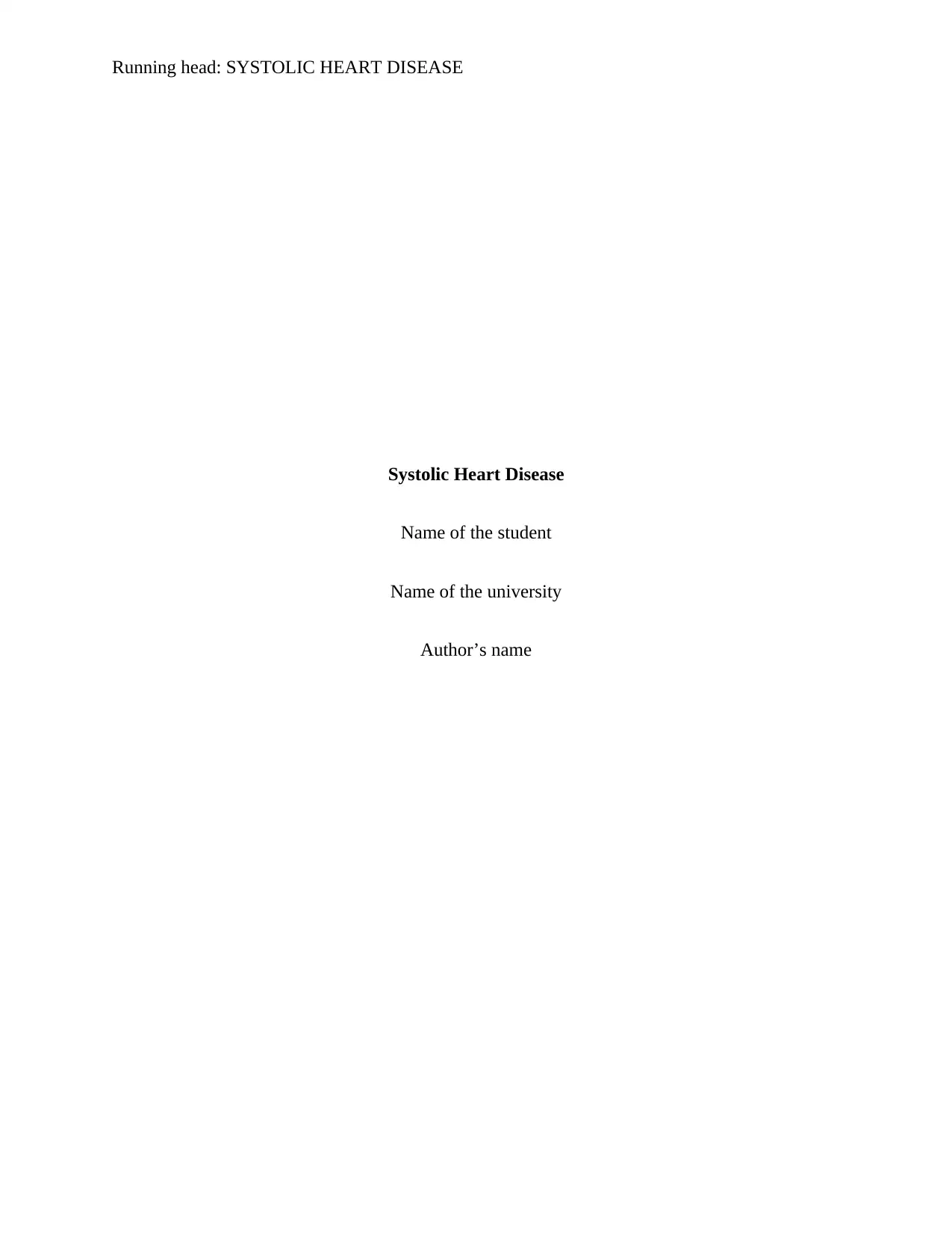
Running head: SYSTOLIC HEART DISEASE
Systolic Heart Disease
Name of the student
Name of the university
Author’s name
Systolic Heart Disease
Name of the student
Name of the university
Author’s name
Secure Best Marks with AI Grader
Need help grading? Try our AI Grader for instant feedback on your assignments.
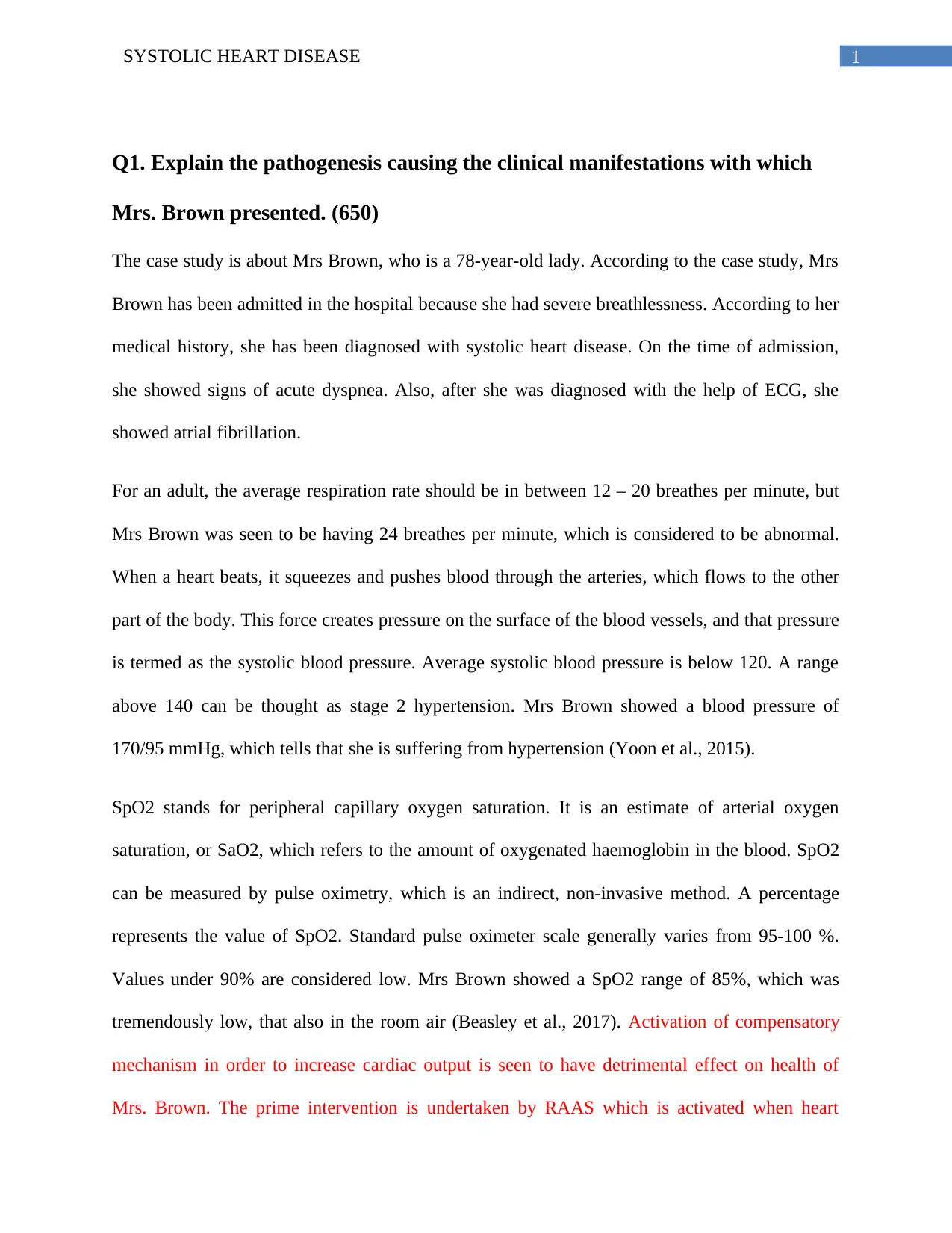
1SYSTOLIC HEART DISEASE
Q1. Explain the pathogenesis causing the clinical manifestations with which
Mrs. Brown presented. (650)
The case study is about Mrs Brown, who is a 78-year-old lady. According to the case study, Mrs
Brown has been admitted in the hospital because she had severe breathlessness. According to her
medical history, she has been diagnosed with systolic heart disease. On the time of admission,
she showed signs of acute dyspnea. Also, after she was diagnosed with the help of ECG, she
showed atrial fibrillation.
For an adult, the average respiration rate should be in between 12 – 20 breathes per minute, but
Mrs Brown was seen to be having 24 breathes per minute, which is considered to be abnormal.
When a heart beats, it squeezes and pushes blood through the arteries, which flows to the other
part of the body. This force creates pressure on the surface of the blood vessels, and that pressure
is termed as the systolic blood pressure. Average systolic blood pressure is below 120. A range
above 140 can be thought as stage 2 hypertension. Mrs Brown showed a blood pressure of
170/95 mmHg, which tells that she is suffering from hypertension (Yoon et al., 2015).
SpO2 stands for peripheral capillary oxygen saturation. It is an estimate of arterial oxygen
saturation, or SaO2, which refers to the amount of oxygenated haemoglobin in the blood. SpO2
can be measured by pulse oximetry, which is an indirect, non-invasive method. A percentage
represents the value of SpO2. Standard pulse oximeter scale generally varies from 95-100 %.
Values under 90% are considered low. Mrs Brown showed a SpO2 range of 85%, which was
tremendously low, that also in the room air (Beasley et al., 2017). Activation of compensatory
mechanism in order to increase cardiac output is seen to have detrimental effect on health of
Mrs. Brown. The prime intervention is undertaken by RAAS which is activated when heart
Q1. Explain the pathogenesis causing the clinical manifestations with which
Mrs. Brown presented. (650)
The case study is about Mrs Brown, who is a 78-year-old lady. According to the case study, Mrs
Brown has been admitted in the hospital because she had severe breathlessness. According to her
medical history, she has been diagnosed with systolic heart disease. On the time of admission,
she showed signs of acute dyspnea. Also, after she was diagnosed with the help of ECG, she
showed atrial fibrillation.
For an adult, the average respiration rate should be in between 12 – 20 breathes per minute, but
Mrs Brown was seen to be having 24 breathes per minute, which is considered to be abnormal.
When a heart beats, it squeezes and pushes blood through the arteries, which flows to the other
part of the body. This force creates pressure on the surface of the blood vessels, and that pressure
is termed as the systolic blood pressure. Average systolic blood pressure is below 120. A range
above 140 can be thought as stage 2 hypertension. Mrs Brown showed a blood pressure of
170/95 mmHg, which tells that she is suffering from hypertension (Yoon et al., 2015).
SpO2 stands for peripheral capillary oxygen saturation. It is an estimate of arterial oxygen
saturation, or SaO2, which refers to the amount of oxygenated haemoglobin in the blood. SpO2
can be measured by pulse oximetry, which is an indirect, non-invasive method. A percentage
represents the value of SpO2. Standard pulse oximeter scale generally varies from 95-100 %.
Values under 90% are considered low. Mrs Brown showed a SpO2 range of 85%, which was
tremendously low, that also in the room air (Beasley et al., 2017). Activation of compensatory
mechanism in order to increase cardiac output is seen to have detrimental effect on health of
Mrs. Brown. The prime intervention is undertaken by RAAS which is activated when heart
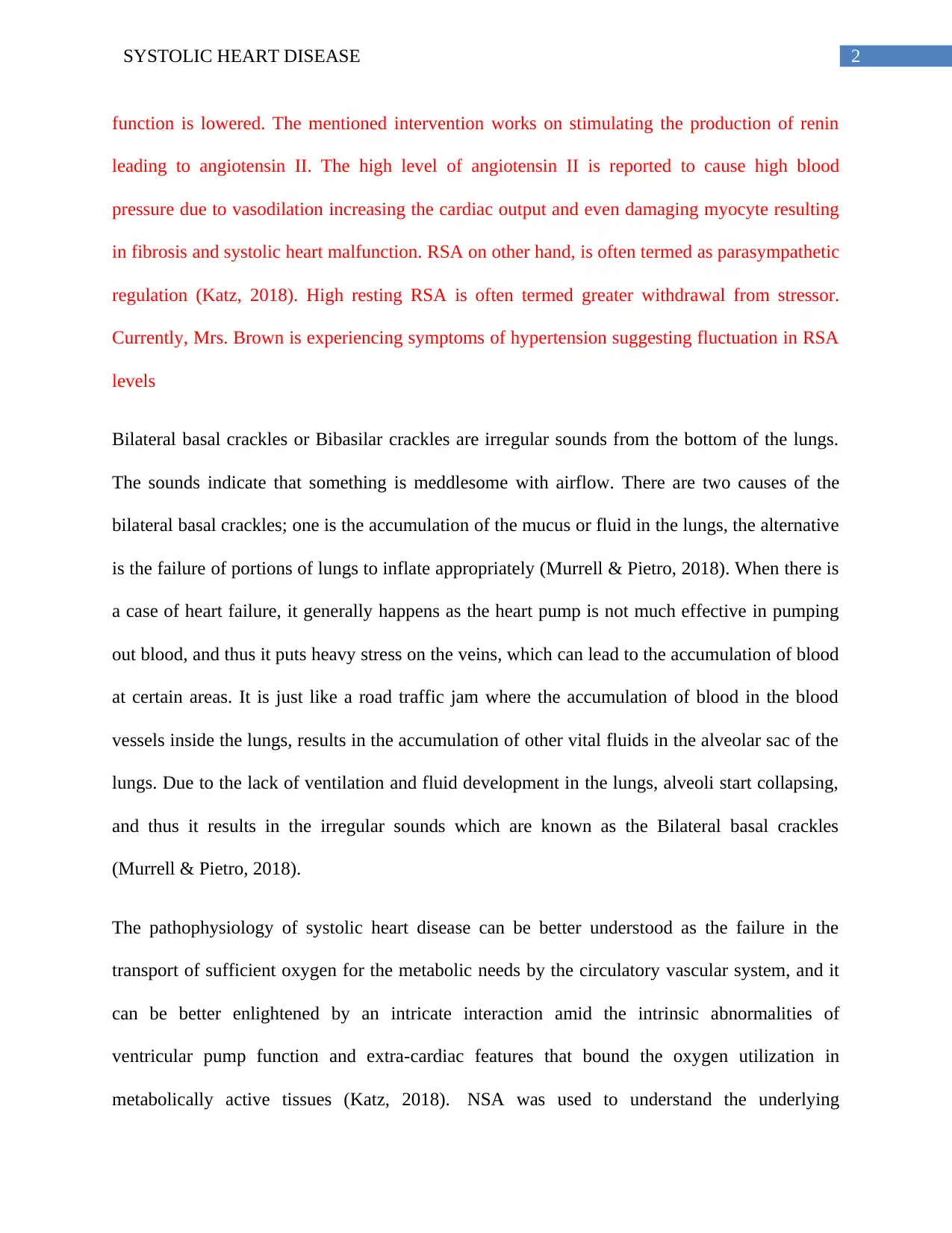
2SYSTOLIC HEART DISEASE
function is lowered. The mentioned intervention works on stimulating the production of renin
leading to angiotensin II. The high level of angiotensin II is reported to cause high blood
pressure due to vasodilation increasing the cardiac output and even damaging myocyte resulting
in fibrosis and systolic heart malfunction. RSA on other hand, is often termed as parasympathetic
regulation (Katz, 2018). High resting RSA is often termed greater withdrawal from stressor.
Currently, Mrs. Brown is experiencing symptoms of hypertension suggesting fluctuation in RSA
levels
Bilateral basal crackles or Bibasilar crackles are irregular sounds from the bottom of the lungs.
The sounds indicate that something is meddlesome with airflow. There are two causes of the
bilateral basal crackles; one is the accumulation of the mucus or fluid in the lungs, the alternative
is the failure of portions of lungs to inflate appropriately (Murrell & Pietro, 2018). When there is
a case of heart failure, it generally happens as the heart pump is not much effective in pumping
out blood, and thus it puts heavy stress on the veins, which can lead to the accumulation of blood
at certain areas. It is just like a road traffic jam where the accumulation of blood in the blood
vessels inside the lungs, results in the accumulation of other vital fluids in the alveolar sac of the
lungs. Due to the lack of ventilation and fluid development in the lungs, alveoli start collapsing,
and thus it results in the irregular sounds which are known as the Bilateral basal crackles
(Murrell & Pietro, 2018).
The pathophysiology of systolic heart disease can be better understood as the failure in the
transport of sufficient oxygen for the metabolic needs by the circulatory vascular system, and it
can be better enlightened by an intricate interaction amid the intrinsic abnormalities of
ventricular pump function and extra-cardiac features that bound the oxygen utilization in
metabolically active tissues (Katz, 2018). NSA was used to understand the underlying
function is lowered. The mentioned intervention works on stimulating the production of renin
leading to angiotensin II. The high level of angiotensin II is reported to cause high blood
pressure due to vasodilation increasing the cardiac output and even damaging myocyte resulting
in fibrosis and systolic heart malfunction. RSA on other hand, is often termed as parasympathetic
regulation (Katz, 2018). High resting RSA is often termed greater withdrawal from stressor.
Currently, Mrs. Brown is experiencing symptoms of hypertension suggesting fluctuation in RSA
levels
Bilateral basal crackles or Bibasilar crackles are irregular sounds from the bottom of the lungs.
The sounds indicate that something is meddlesome with airflow. There are two causes of the
bilateral basal crackles; one is the accumulation of the mucus or fluid in the lungs, the alternative
is the failure of portions of lungs to inflate appropriately (Murrell & Pietro, 2018). When there is
a case of heart failure, it generally happens as the heart pump is not much effective in pumping
out blood, and thus it puts heavy stress on the veins, which can lead to the accumulation of blood
at certain areas. It is just like a road traffic jam where the accumulation of blood in the blood
vessels inside the lungs, results in the accumulation of other vital fluids in the alveolar sac of the
lungs. Due to the lack of ventilation and fluid development in the lungs, alveoli start collapsing,
and thus it results in the irregular sounds which are known as the Bilateral basal crackles
(Murrell & Pietro, 2018).
The pathophysiology of systolic heart disease can be better understood as the failure in the
transport of sufficient oxygen for the metabolic needs by the circulatory vascular system, and it
can be better enlightened by an intricate interaction amid the intrinsic abnormalities of
ventricular pump function and extra-cardiac features that bound the oxygen utilization in
metabolically active tissues (Katz, 2018). NSA was used to understand the underlying
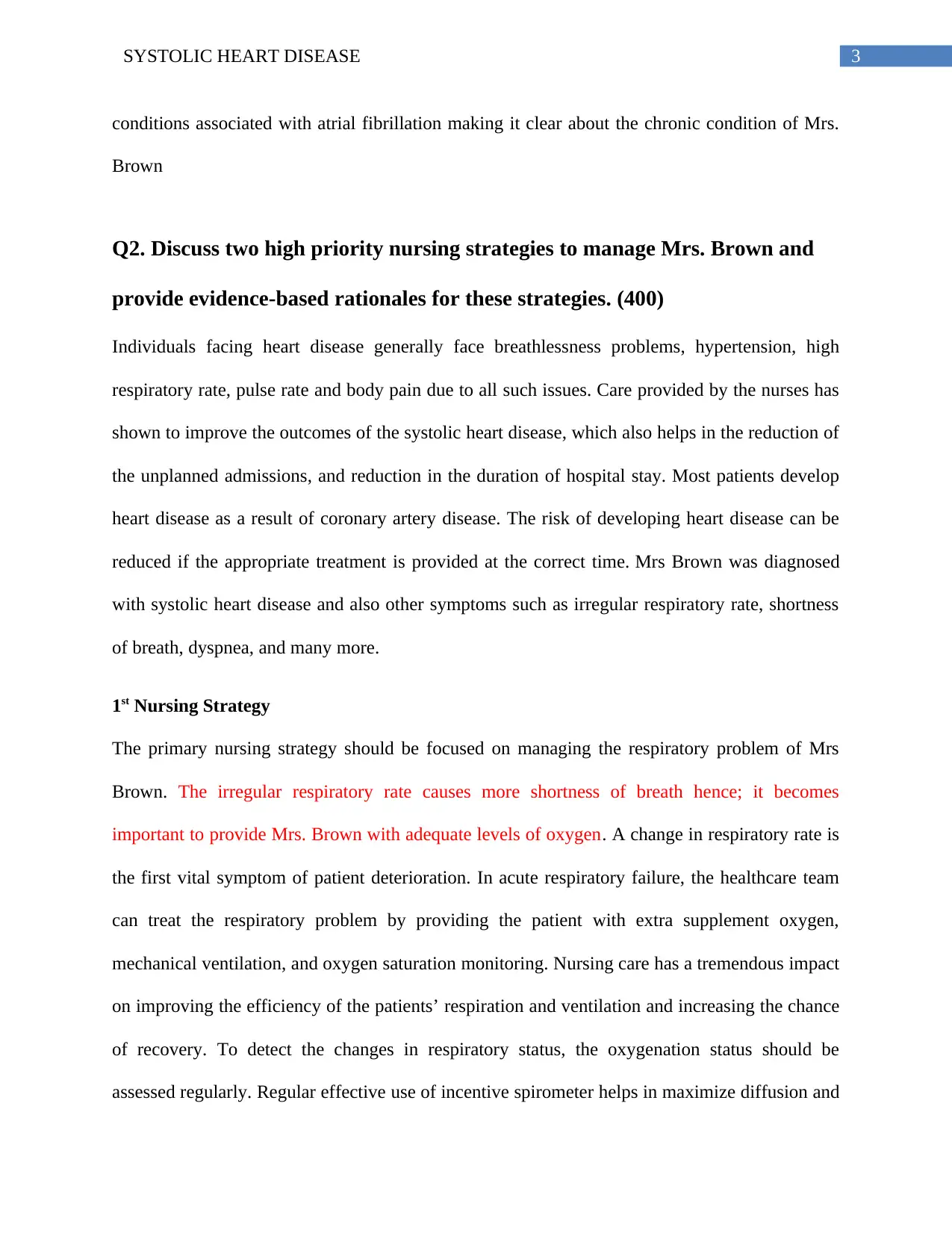
3SYSTOLIC HEART DISEASE
conditions associated with atrial fibrillation making it clear about the chronic condition of Mrs.
Brown
Q2. Discuss two high priority nursing strategies to manage Mrs. Brown and
provide evidence-based rationales for these strategies. (400)
Individuals facing heart disease generally face breathlessness problems, hypertension, high
respiratory rate, pulse rate and body pain due to all such issues. Care provided by the nurses has
shown to improve the outcomes of the systolic heart disease, which also helps in the reduction of
the unplanned admissions, and reduction in the duration of hospital stay. Most patients develop
heart disease as a result of coronary artery disease. The risk of developing heart disease can be
reduced if the appropriate treatment is provided at the correct time. Mrs Brown was diagnosed
with systolic heart disease and also other symptoms such as irregular respiratory rate, shortness
of breath, dyspnea, and many more.
1st Nursing Strategy
The primary nursing strategy should be focused on managing the respiratory problem of Mrs
Brown. The irregular respiratory rate causes more shortness of breath hence; it becomes
important to provide Mrs. Brown with adequate levels of oxygen. A change in respiratory rate is
the first vital symptom of patient deterioration. In acute respiratory failure, the healthcare team
can treat the respiratory problem by providing the patient with extra supplement oxygen,
mechanical ventilation, and oxygen saturation monitoring. Nursing care has a tremendous impact
on improving the efficiency of the patients’ respiration and ventilation and increasing the chance
of recovery. To detect the changes in respiratory status, the oxygenation status should be
assessed regularly. Regular effective use of incentive spirometer helps in maximize diffusion and
conditions associated with atrial fibrillation making it clear about the chronic condition of Mrs.
Brown
Q2. Discuss two high priority nursing strategies to manage Mrs. Brown and
provide evidence-based rationales for these strategies. (400)
Individuals facing heart disease generally face breathlessness problems, hypertension, high
respiratory rate, pulse rate and body pain due to all such issues. Care provided by the nurses has
shown to improve the outcomes of the systolic heart disease, which also helps in the reduction of
the unplanned admissions, and reduction in the duration of hospital stay. Most patients develop
heart disease as a result of coronary artery disease. The risk of developing heart disease can be
reduced if the appropriate treatment is provided at the correct time. Mrs Brown was diagnosed
with systolic heart disease and also other symptoms such as irregular respiratory rate, shortness
of breath, dyspnea, and many more.
1st Nursing Strategy
The primary nursing strategy should be focused on managing the respiratory problem of Mrs
Brown. The irregular respiratory rate causes more shortness of breath hence; it becomes
important to provide Mrs. Brown with adequate levels of oxygen. A change in respiratory rate is
the first vital symptom of patient deterioration. In acute respiratory failure, the healthcare team
can treat the respiratory problem by providing the patient with extra supplement oxygen,
mechanical ventilation, and oxygen saturation monitoring. Nursing care has a tremendous impact
on improving the efficiency of the patients’ respiration and ventilation and increasing the chance
of recovery. To detect the changes in respiratory status, the oxygenation status should be
assessed regularly. Regular effective use of incentive spirometer helps in maximize diffusion and
Secure Best Marks with AI Grader
Need help grading? Try our AI Grader for instant feedback on your assignments.
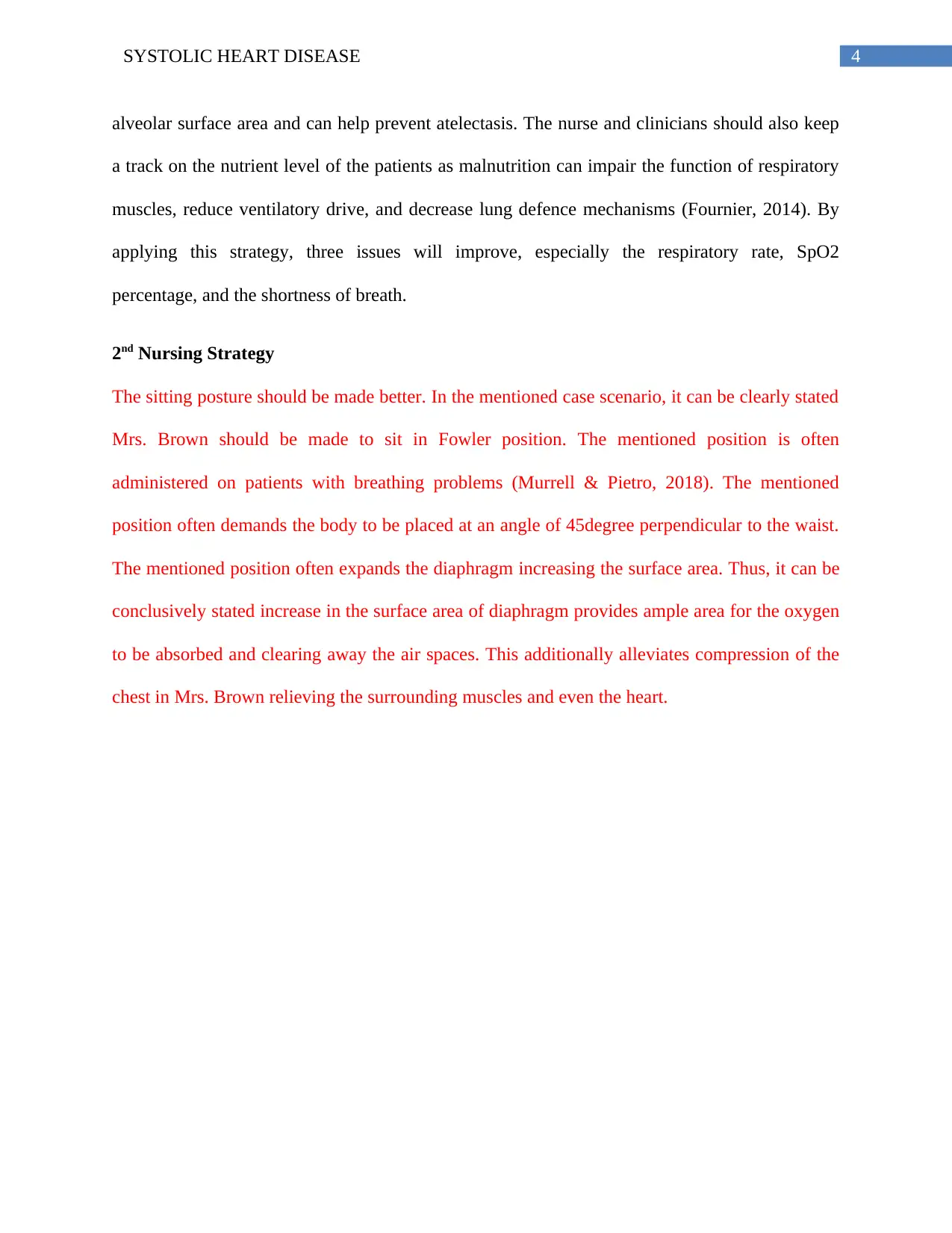
4SYSTOLIC HEART DISEASE
alveolar surface area and can help prevent atelectasis. The nurse and clinicians should also keep
a track on the nutrient level of the patients as malnutrition can impair the function of respiratory
muscles, reduce ventilatory drive, and decrease lung defence mechanisms (Fournier, 2014). By
applying this strategy, three issues will improve, especially the respiratory rate, SpO2
percentage, and the shortness of breath.
2nd Nursing Strategy
The sitting posture should be made better. In the mentioned case scenario, it can be clearly stated
Mrs. Brown should be made to sit in Fowler position. The mentioned position is often
administered on patients with breathing problems (Murrell & Pietro, 2018). The mentioned
position often demands the body to be placed at an angle of 45degree perpendicular to the waist.
The mentioned position often expands the diaphragm increasing the surface area. Thus, it can be
conclusively stated increase in the surface area of diaphragm provides ample area for the oxygen
to be absorbed and clearing away the air spaces. This additionally alleviates compression of the
chest in Mrs. Brown relieving the surrounding muscles and even the heart.
alveolar surface area and can help prevent atelectasis. The nurse and clinicians should also keep
a track on the nutrient level of the patients as malnutrition can impair the function of respiratory
muscles, reduce ventilatory drive, and decrease lung defence mechanisms (Fournier, 2014). By
applying this strategy, three issues will improve, especially the respiratory rate, SpO2
percentage, and the shortness of breath.
2nd Nursing Strategy
The sitting posture should be made better. In the mentioned case scenario, it can be clearly stated
Mrs. Brown should be made to sit in Fowler position. The mentioned position is often
administered on patients with breathing problems (Murrell & Pietro, 2018). The mentioned
position often demands the body to be placed at an angle of 45degree perpendicular to the waist.
The mentioned position often expands the diaphragm increasing the surface area. Thus, it can be
conclusively stated increase in the surface area of diaphragm provides ample area for the oxygen
to be absorbed and clearing away the air spaces. This additionally alleviates compression of the
chest in Mrs. Brown relieving the surrounding muscles and even the heart.
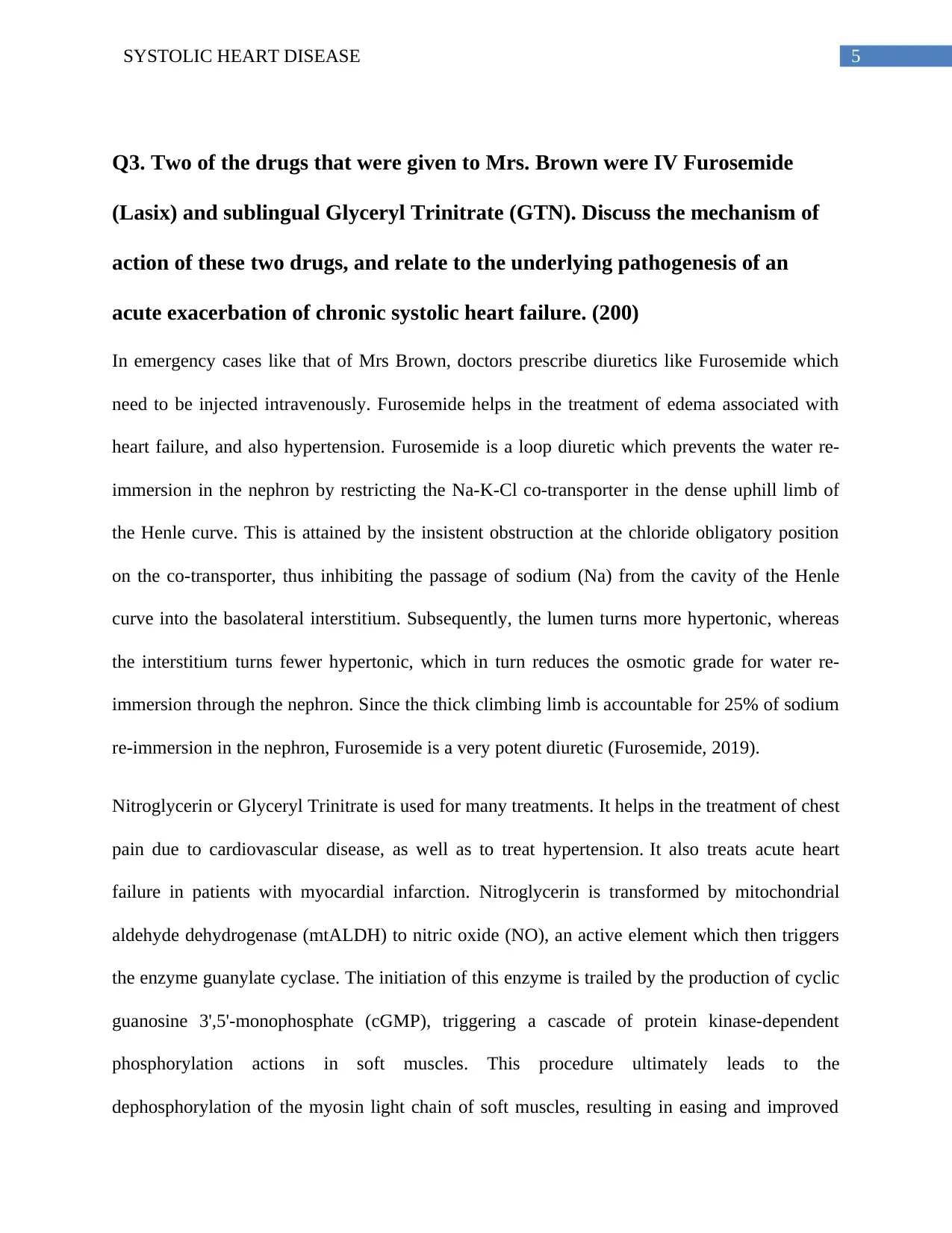
5SYSTOLIC HEART DISEASE
Q3. Two of the drugs that were given to Mrs. Brown were IV Furosemide
(Lasix) and sublingual Glyceryl Trinitrate (GTN). Discuss the mechanism of
action of these two drugs, and relate to the underlying pathogenesis of an
acute exacerbation of chronic systolic heart failure. (200)
In emergency cases like that of Mrs Brown, doctors prescribe diuretics like Furosemide which
need to be injected intravenously. Furosemide helps in the treatment of edema associated with
heart failure, and also hypertension. Furosemide is a loop diuretic which prevents the water re-
immersion in the nephron by restricting the Na-K-Cl co-transporter in the dense uphill limb of
the Henle curve. This is attained by the insistent obstruction at the chloride obligatory position
on the co-transporter, thus inhibiting the passage of sodium (Na) from the cavity of the Henle
curve into the basolateral interstitium. Subsequently, the lumen turns more hypertonic, whereas
the interstitium turns fewer hypertonic, which in turn reduces the osmotic grade for water re-
immersion through the nephron. Since the thick climbing limb is accountable for 25% of sodium
re-immersion in the nephron, Furosemide is a very potent diuretic (Furosemide, 2019).
Nitroglycerin or Glyceryl Trinitrate is used for many treatments. It helps in the treatment of chest
pain due to cardiovascular disease, as well as to treat hypertension. It also treats acute heart
failure in patients with myocardial infarction. Nitroglycerin is transformed by mitochondrial
aldehyde dehydrogenase (mtALDH) to nitric oxide (NO), an active element which then triggers
the enzyme guanylate cyclase. The initiation of this enzyme is trailed by the production of cyclic
guanosine 3',5'-monophosphate (cGMP), triggering a cascade of protein kinase-dependent
phosphorylation actions in soft muscles. This procedure ultimately leads to the
dephosphorylation of the myosin light chain of soft muscles, resulting in easing and improved
Q3. Two of the drugs that were given to Mrs. Brown were IV Furosemide
(Lasix) and sublingual Glyceryl Trinitrate (GTN). Discuss the mechanism of
action of these two drugs, and relate to the underlying pathogenesis of an
acute exacerbation of chronic systolic heart failure. (200)
In emergency cases like that of Mrs Brown, doctors prescribe diuretics like Furosemide which
need to be injected intravenously. Furosemide helps in the treatment of edema associated with
heart failure, and also hypertension. Furosemide is a loop diuretic which prevents the water re-
immersion in the nephron by restricting the Na-K-Cl co-transporter in the dense uphill limb of
the Henle curve. This is attained by the insistent obstruction at the chloride obligatory position
on the co-transporter, thus inhibiting the passage of sodium (Na) from the cavity of the Henle
curve into the basolateral interstitium. Subsequently, the lumen turns more hypertonic, whereas
the interstitium turns fewer hypertonic, which in turn reduces the osmotic grade for water re-
immersion through the nephron. Since the thick climbing limb is accountable for 25% of sodium
re-immersion in the nephron, Furosemide is a very potent diuretic (Furosemide, 2019).
Nitroglycerin or Glyceryl Trinitrate is used for many treatments. It helps in the treatment of chest
pain due to cardiovascular disease, as well as to treat hypertension. It also treats acute heart
failure in patients with myocardial infarction. Nitroglycerin is transformed by mitochondrial
aldehyde dehydrogenase (mtALDH) to nitric oxide (NO), an active element which then triggers
the enzyme guanylate cyclase. The initiation of this enzyme is trailed by the production of cyclic
guanosine 3',5'-monophosphate (cGMP), triggering a cascade of protein kinase-dependent
phosphorylation actions in soft muscles. This procedure ultimately leads to the
dephosphorylation of the myosin light chain of soft muscles, resulting in easing and improved
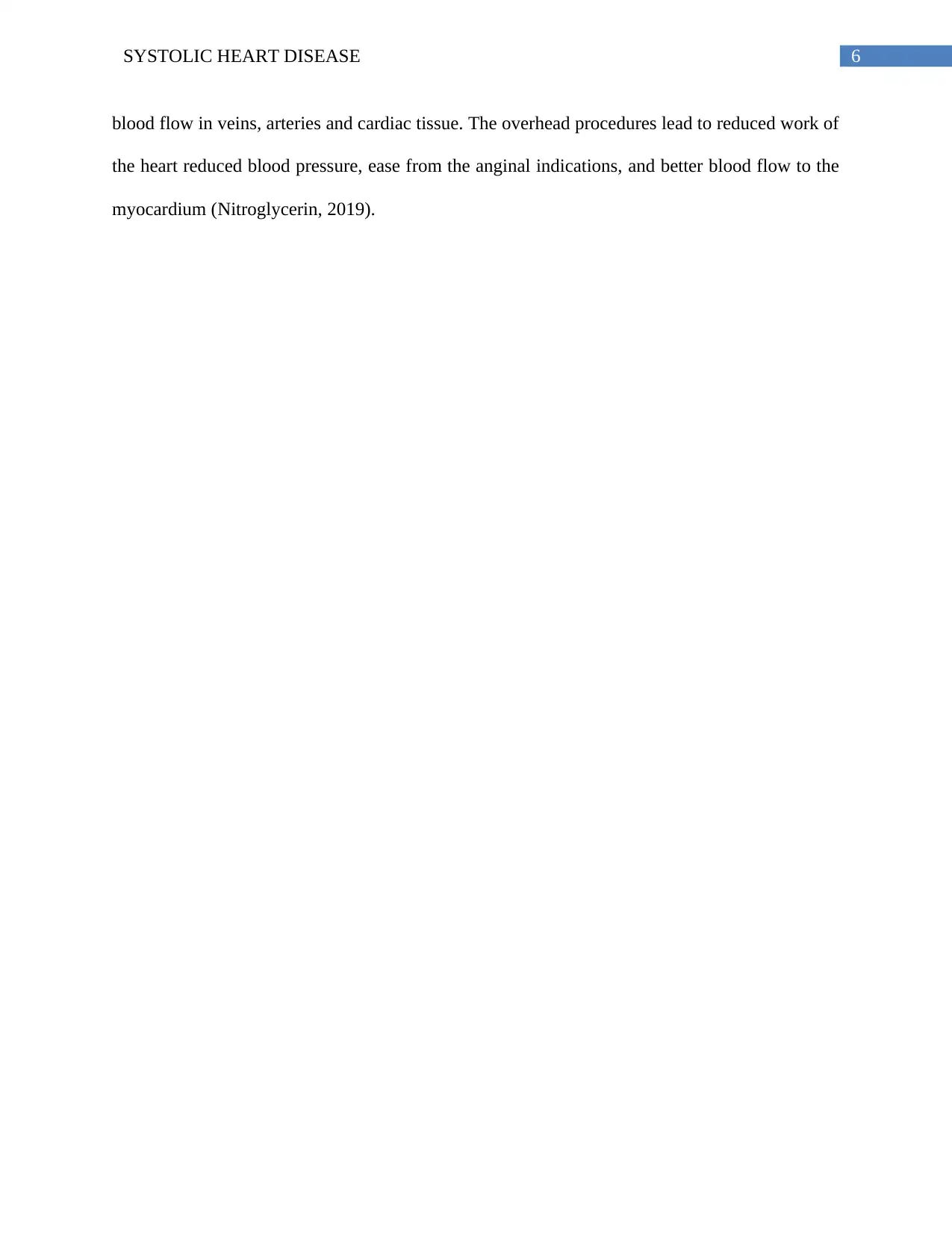
6SYSTOLIC HEART DISEASE
blood flow in veins, arteries and cardiac tissue. The overhead procedures lead to reduced work of
the heart reduced blood pressure, ease from the anginal indications, and better blood flow to the
myocardium (Nitroglycerin, 2019).
blood flow in veins, arteries and cardiac tissue. The overhead procedures lead to reduced work of
the heart reduced blood pressure, ease from the anginal indications, and better blood flow to the
myocardium (Nitroglycerin, 2019).
Paraphrase This Document
Need a fresh take? Get an instant paraphrase of this document with our AI Paraphraser
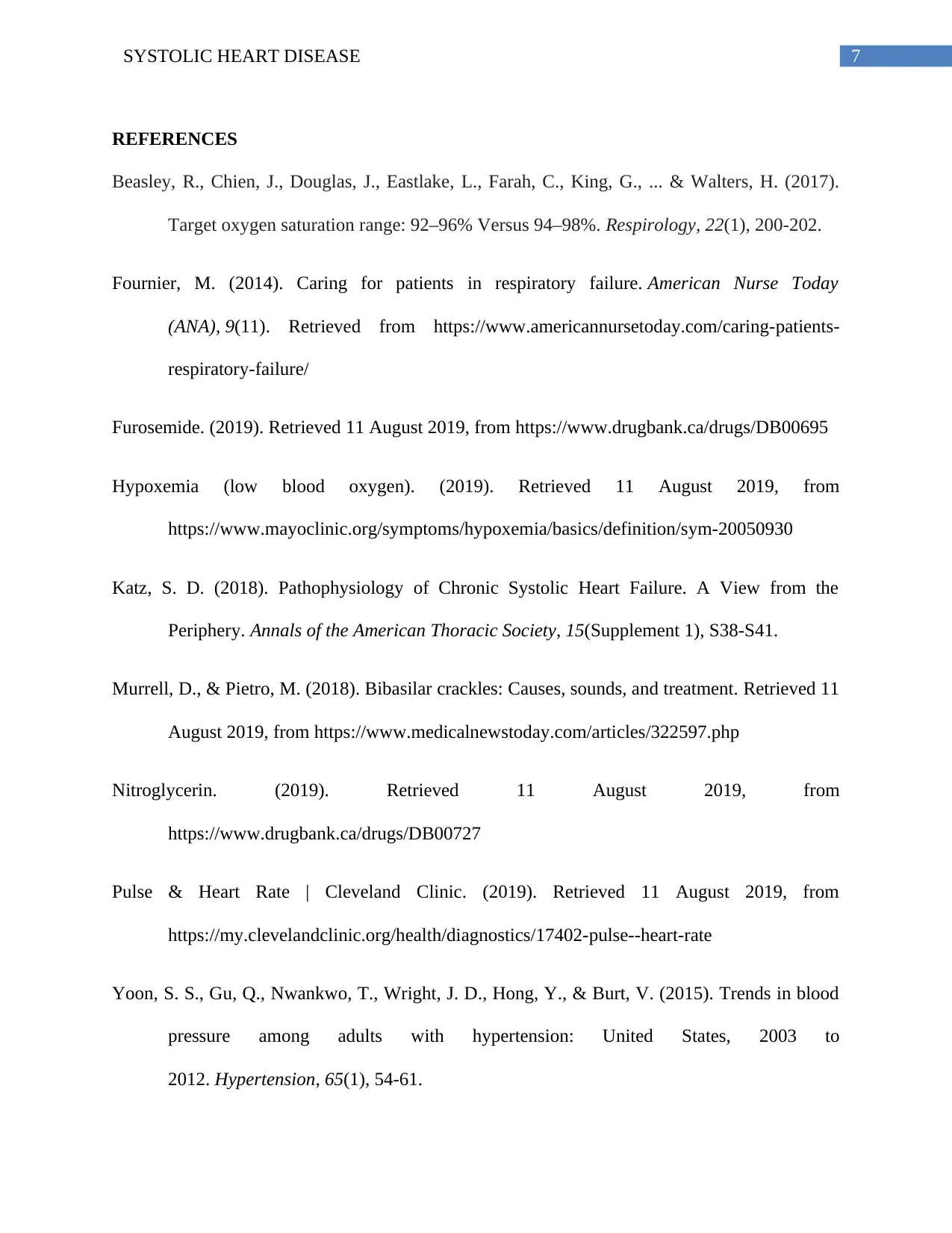
7SYSTOLIC HEART DISEASE
REFERENCES
Beasley, R., Chien, J., Douglas, J., Eastlake, L., Farah, C., King, G., ... & Walters, H. (2017).
Target oxygen saturation range: 92–96% Versus 94–98%. Respirology, 22(1), 200-202.
Fournier, M. (2014). Caring for patients in respiratory failure. American Nurse Today
(ANA), 9(11). Retrieved from https://www.americannursetoday.com/caring-patients-
respiratory-failure/
Furosemide. (2019). Retrieved 11 August 2019, from https://www.drugbank.ca/drugs/DB00695
Hypoxemia (low blood oxygen). (2019). Retrieved 11 August 2019, from
https://www.mayoclinic.org/symptoms/hypoxemia/basics/definition/sym-20050930
Katz, S. D. (2018). Pathophysiology of Chronic Systolic Heart Failure. A View from the
Periphery. Annals of the American Thoracic Society, 15(Supplement 1), S38-S41.
Murrell, D., & Pietro, M. (2018). Bibasilar crackles: Causes, sounds, and treatment. Retrieved 11
August 2019, from https://www.medicalnewstoday.com/articles/322597.php
Nitroglycerin. (2019). Retrieved 11 August 2019, from
https://www.drugbank.ca/drugs/DB00727
Pulse & Heart Rate | Cleveland Clinic. (2019). Retrieved 11 August 2019, from
https://my.clevelandclinic.org/health/diagnostics/17402-pulse--heart-rate
Yoon, S. S., Gu, Q., Nwankwo, T., Wright, J. D., Hong, Y., & Burt, V. (2015). Trends in blood
pressure among adults with hypertension: United States, 2003 to
2012. Hypertension, 65(1), 54-61.
REFERENCES
Beasley, R., Chien, J., Douglas, J., Eastlake, L., Farah, C., King, G., ... & Walters, H. (2017).
Target oxygen saturation range: 92–96% Versus 94–98%. Respirology, 22(1), 200-202.
Fournier, M. (2014). Caring for patients in respiratory failure. American Nurse Today
(ANA), 9(11). Retrieved from https://www.americannursetoday.com/caring-patients-
respiratory-failure/
Furosemide. (2019). Retrieved 11 August 2019, from https://www.drugbank.ca/drugs/DB00695
Hypoxemia (low blood oxygen). (2019). Retrieved 11 August 2019, from
https://www.mayoclinic.org/symptoms/hypoxemia/basics/definition/sym-20050930
Katz, S. D. (2018). Pathophysiology of Chronic Systolic Heart Failure. A View from the
Periphery. Annals of the American Thoracic Society, 15(Supplement 1), S38-S41.
Murrell, D., & Pietro, M. (2018). Bibasilar crackles: Causes, sounds, and treatment. Retrieved 11
August 2019, from https://www.medicalnewstoday.com/articles/322597.php
Nitroglycerin. (2019). Retrieved 11 August 2019, from
https://www.drugbank.ca/drugs/DB00727
Pulse & Heart Rate | Cleveland Clinic. (2019). Retrieved 11 August 2019, from
https://my.clevelandclinic.org/health/diagnostics/17402-pulse--heart-rate
Yoon, S. S., Gu, Q., Nwankwo, T., Wright, J. D., Hong, Y., & Burt, V. (2015). Trends in blood
pressure among adults with hypertension: United States, 2003 to
2012. Hypertension, 65(1), 54-61.
1 out of 8
Related Documents
Your All-in-One AI-Powered Toolkit for Academic Success.
+13062052269
info@desklib.com
Available 24*7 on WhatsApp / Email
![[object Object]](/_next/static/media/star-bottom.7253800d.svg)
Unlock your academic potential
© 2024 | Zucol Services PVT LTD | All rights reserved.





